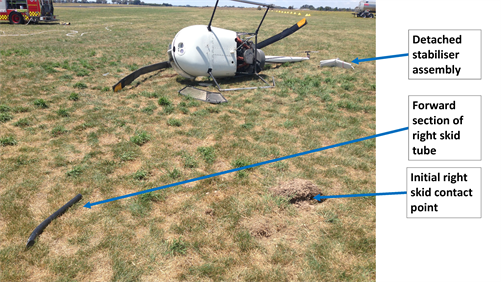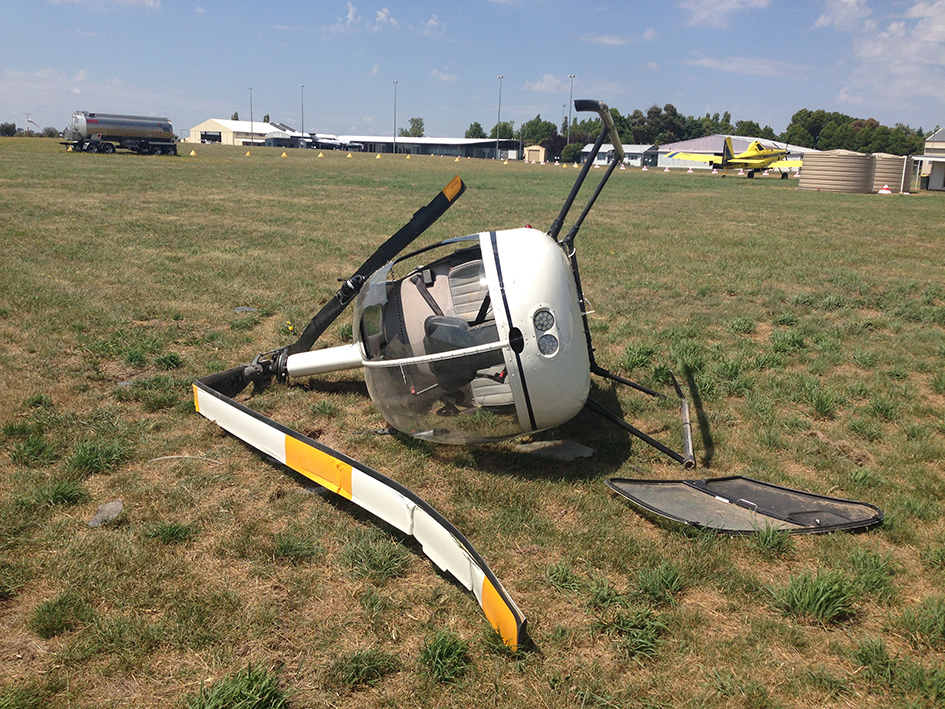What happened
On 10 February 2015, at about 1145 Eastern Daylight-saving Time (EDT), an instructor and student were conducting an in-ground-effect[1] hover lesson in a Robinson R22, registered VH-YLP (YLP) at Orange Airport, New South Wales.
The lesson had covered individual effect and use of the pedals, the collective[2] and the cyclic[3] and included student practice immediately after each instructor demonstration. Throughout the lesson, the student had progressed from individual use of each control separately, to coordinating combinations of the three controls.
The instructor reported that at times during the student practice, the student allowed the helicopter to hover sideways or forwards, and instead of easing the cyclic or pushing the cyclic in the opposite direction to counter this movement, the student incorrectly pushed it in the direction of movement. Hence on a couple of occasions, the instructor re-briefed the correct procedure.
In the last few minutes of the hour long lesson, the student requested a little more time to practice the new sequences. A few moments into this practice, at about 3 ft above ground level (AGL), with the student controlling the cyclic and the instructor lightly controlling the pedals and collective, the helicopter began to roll to the right and move rearwards. The student reacted quickly, but moved the cyclic further backwards and to the right, which resulted in an increase in the rearward speed in this direction. The instructor attempted to regain control, but due to the sudden rearward movement of the cyclic, his thumb had bent back behind his wrist. The instructor managed to ‘grab’ the collective and lift it up a small amount, but by the time any significant control input could be applied, the right skid had struck the ground (Figure 1). The helicopter rolled further to the right, and fell onto the ground. The manner in which the helicopter had pivoted around the right skid and fallen onto its side was described by both the instructor and operator as dynamic rollover[4].
The student and instructor exited the helicopter and moved clear. The instructor was not injured, however the student received minor injuries and the helicopter was substantially damaged.
Instructor experience and comments
The instructor had about 735 hours of helicopter flying experience, with the majority of their commercial experience working as an instructor.
Prior to the lesson, the instructor had conducted a 45-minute pre-flight briefing with the student. This covered the aims, objectives and sequences to be covered in the flight lesson, and also looked at preventative measures to assist in mitigating against any potential threats and errors, including dynamic rollover.
During the flying component of the lesson, the in-ground-effect hover had been practiced at about 3ft. The instructor also reported that with the high temperature and density altitude on the day, the helicopter had limited excess power available.
Figure 1: VH-YLP showing initial contact point

Source: Operator
At the time of the accident, the instructor reported that the student was using all three controls and the instructor was lightly on the collective and pedals, monitoring the student’s performance.
Due to the hot and dry conditions in the previous few weeks, the ground was very hard and dry and caused the helicopter to bounce when the skid first impacted the ground. This further exacerbated the helicopter’s instability.
The instructor felt that as soon as the helicopter tilted to the right, the blades probably struck the ground; the instructor also commented how quickly the whole event happened.
In hindsight, the instructor felt that as the student had progressed so well throughout the lesson, this had possibly influenced the decision for a little less intense instructor engagement, with a belief that with direction, the student would be able to recover the helicopter from the rearward motion. This allowed critical moments of delay when attempting to regain control when it was required.
Student experience and comments
The student had a total of about 5 flying hours, all on helicopters. This was the student’s first lesson in hovering and fifth lesson overall. The student reported that, with the intense instruction throughout the session, it is possible that they both lost situational awareness in relation to proximity to the ground. The student reported that at the time of the loss of control, the instructor had control of the collective and the pedals while they retained control of the cyclic.
The student commented that they felt it would be advantageous to practice sequences such as effects of controls at a higher altitude, gradually moving closer to the ground with increased competence.
The student also noted that they often felt quite tired at the end of an hour long lesson, as there was so much new information to understand and put into practice.
Figure 2: Detached right door and damaged rotor blades

Source: Operator
Operator comments
During the last ten minutes of the dual lesson, the heel of the right skid contacted the ground and the helicopter moved approximately 4 m to the right before coming to rest on its right side.
It is most likely that applied collective pitch may have been the reason for the movement laterally. When the helicopter moved rearward, the student was instructed to correct the unwanted movement. Initially the student applied incorrect aft cyclic, which increased the velocity of the unwanted movement and a subsequent sink off the ‘ground cushion’ created by the downwash from the rotor blades.
The company also identified that the hover height for the sequence was too low.
ATSB Comment
As noted by the instructor and the operator, the pivoting roll by the helicopter to the right, around the skid in contact with the ground, and subsequent loss of control is consistent with the phenomenon known as dynamic rollover.
A helicopter is susceptible to this later roll, but some factor must first cause the helicopter to roll or pivot around a skid until its crucial rollover angle is reached. This angle is around 5° to 8 ° dependent on the type of helicopter, winds and loading.
Once started, dynamic rollover cannot be stopped by application of opposite cycle control alone. Even with full left cyclic applied, the main rotor thrust vector and its moment follows the aircraft as it continues rolling to the right. Quickly reducing collective pitch is the most effective way to stop dynamic rollover from developing.
Further reading on situations leading to dynamic rollover is available at: www.faa.gov./regulations_policies/handbooks_manuals
Safety Message
The role of the instructor as pilot in command is a dynamic and complex one. There remains a fine balance between providing an interesting and beneficial learning experience for your student and keeping the situation safe.
A manual produced by the Civil Aviation Safety Authority (CASA) Australia and the Civil Aviation Authority (CAA) New Zealand for helicopter instructors has many useful tips and tools relating to the principles and methods of flight instruction. It includes 28 chapters on flying sequences from ab initio through to mountain flying awareness.
The manual discusses the need to always closely supervise student practice sequences and to not allow students to make mistakes. It also highlights the necessity of using the correct handing over and taking over model, so there is never any doubt as to who has control at any one time.
In relation to the hovering sequence, it notes that this exercise demands a high degree of coordination and should not be taught until the student has acquired a reasonable state of competence in the first five lessons. An alternative technique is to use slow flight to introduce hovering. This procedure take the form of low, slow flight into the wind across a suitable clear area. Speed and height are progressively reduced in successive passes until the helicopter is creeping forward at a walking pace in ground effect and is then momentarily halted before transitioning into forward flight again. These momentary pauses are in fact periods of hovering, and are gradually extended as competency improves.
The manual is available online at: www.casa.gov.au/scripts/nc.dll?WCMS:STANDARD::pc=PC_90306
Safety action
Whether or not the ATSB identifies safety issues in the course of an investigation, relevant organisations may proactively initiate safety action in order to reduce their safety risk. The ATSB has been advised of the following proactive safety action in response to this occurrence.
Operator
As a result of this occurrence, the aircraft operator has advised the ATSB that they are taking the following safety actions:
Flight training operations
- Since the accident, the company has advised that the hover height should not be below about 1.5 – 2.0 m (5.0 – 6.5 ft) of skid height, particularly in the first or second hover lesson
- Instructor’s hand position must be kept closer to the cyclic during a student’s early training and control should be taken as soon as an unwanted movement starts; do not allow rearward movement of the helicopter at this stage of training
- Care should be taken to adhere to the power limits in the pilot operating handbook and guidance in the operations manual. Caution should be applied to monitor the helicopter’s height above the ground.
Aviation Short Investigations Bulletin - Issue 41
Purpose of safety investigationsThe objective of a safety investigation is to enhance transport safety. This is done through:
It is not a function of the ATSB to apportion blame or provide a means for determining liability. At the same time, an investigation report must include factual material of sufficient weight to support the analysis and findings. At all times the ATSB endeavours to balance the use of material that could imply adverse comment with the need to properly explain what happened, and why, in a fair and unbiased manner. The ATSB does not investigate for the purpose of taking administrative, regulatory or criminal action. TerminologyAn explanation of terminology used in ATSB investigation reports is available here. This includes terms such as occurrence, contributing factor, other factor that increased risk, and safety issue. Publishing informationReleased in accordance with section 25 of the Transport Safety Investigation Act 2003 Published by: Australian Transport Safety Bureau © Commonwealth of Australia 2015
Ownership of intellectual property rights in this publication Unless otherwise noted, copyright (and any other intellectual property rights, if any) in this report publication is owned by the Commonwealth of Australia. Creative Commons licence With the exception of the Coat of Arms, ATSB logo, and photos and graphics in which a third party holds copyright, this publication is licensed under a Creative Commons Attribution 3.0 Australia licence. Creative Commons Attribution 3.0 Australia Licence is a standard form licence agreement that allows you to copy, distribute, transmit and adapt this publication provided that you attribute the work. The ATSB’s preference is that you attribute this publication (and any material sourced from it) using the following wording: Source: Australian Transport Safety Bureau Copyright in material obtained from other agencies, private individuals or organisations, belongs to those agencies, individuals or organisations. Where you wish to use their material, you will need to contact them directly. |
__________
- Ground effect refers to the apparent improvement in helicopter performance near the ground which results from a modification of the airflow through the main rotor due to the interaction of that flow with the ground beneath.
- Collective - a primary helicopter flight control that simultaneously affects the pitch of al blades of a lifting rotor. Collective input is the main control for vertical velocity
- Cyclic - a primary helicopter flight control that is similar to an aircraft control column. Cyclic input tilts the main rotor disc varying the attitude of the helicopter and hence the lateral directions
- Dynamic rollover begins when the helicopter starts to pivot laterally around its skid or wheel.


